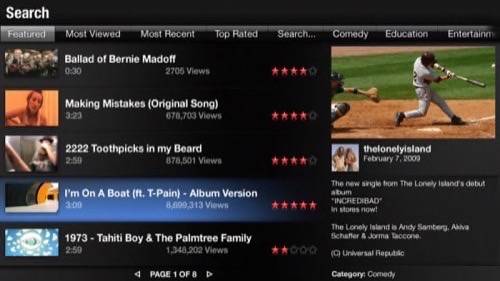
Four years ago, Intel executives stood on stage with representatives from, Yahoo, Comcast, Disney and Sony, with endorsements from CBS and device manufacturers like Motorola, promising to revolutionize the television. They failed.
This week, Intel disclosed that it had launched a new division, dubbed Intel Media, that would set out to give it another try with an Internet television service and set-top box to be released later this year. Erik Huggers, vice president and general manager of Intel Media, spoke at the All Things Digital “Dive into Media” conference on Tuesday, where he confirmed long-standing rumors that his company plans to enter the streaming market with a complex new service. An Intel spokesman added that the box, with a “very unique” user interface, is currently being tested by Intel employees.
Why Will Intel’s TV Plans Work This Time?
Why will Intel succeed this time? The smart money says that it won’t.
Huggers described Intel’s goal as an “all-in-one solution,” providing live television, on-demand, plus what he called “proper” catchup television, modeled on the BBC iPlayer: which offers every second of BBC programming, including radio and television, for seven days after it airs.
The box would also ship with a camera, presumably similar to the Kinect peripheral for the Xbox, that will identify who’s watching and provide targeted ads. The creepy camera won’t scare off viewers, Huggers promised, and the targeted advertising will apparently pay for some of the content deals that Intel will provide.
Not only will Intel be providing a streaming box – naturally equipped with an Intel chip – but the streaming box will also come with a kind of cable hybrid subscription service, of which there are not many details at the moment. It’s likely that customers will get the streaming mainstays – Netflix, at least, plus services like Hulu and possibly Amazon. But Huggers also said that his company has been working with content providers to offer programming not offered through the usual non-cable services.
Playing Nice With Big Content Providers?
“We are working with everyone right now, and we are confident that by the time we launch, we’ll have a very compelling product,” Huggers said.
That’s unlikely, though. So far, Huggers hasn’t identified who is responsible for the company’s content licensing efforts.
At the All Things D event, Huggers said that his marketing chief is a woman who helped launch Apple’s “iProducts,” plus he has executives with experience from Netflix and the BBC on board. But so far, he hasn’t put forward a point person on content.
History proves that Intel hasn’t had much traction in this area.
The Yahoo-Intel partnership began life as the “Yahoo Widgets Channel” – which debuted on TVs from Samsung, Sony and Vizio. But the widgets, little mini-apps that provided bare-bones interfaces to services like Netflix and sites like HGTV, quickly faded into obscurity. Today, Yahoo Widgets have been replaced by the more consumer-friendly “Apps.” Yes, Yahoo has a Web app store, but its connected TV platform doesn’t. On the other hand, it has struck deals with the National Geographic Channel and Showtime for “broadcast interactivity,” sort of a second-screen experience actually on the TV screen, like Google TV – another platform that has struggled for relevance. It was telling that Huggers also referred demeaningly to the problems that his son had in using the television remotes to load up Netflix – not only was there no mention of the Yahoo partnership, but apparently current solutions weren’t good enough.
Here’s another thing to consider: in Sept. 2010, Google hired Robert Kyncl, Netflix’s content chief, to be its emissary to the studios. It took until May 2011 for Google to add 3,000 movies to rent, including “blockbusters” like Oscar winner The King’s Speech. It took even longer to bring Google Play up to speed with other online services. The point is that negotiating content deals can be a long and painful process – and that’s just to keep up with the Joneses, much less break new ground.
Huggers did tease the possibility of a la carte programming – being able to purchase a subscription to ABC, ESPN, Syfy and nothing else, for example – before pulling it back. “I believe that if bundles are… bundled correctly, they add tremendous value,” he said, referring to the “curation” that presumably broadcasters provide.
But Intel’s offering, on the surface, doesn’t appear to be any cheaper than what anyone else is offering. “It’s not a value play, it’s a quality play where we’ll create a superior experience for the end user,” Huggers said with respect to the cost comparison between Intel’s offering and traditional cable.
But with that said, it’s hard to see at the moment what will differentiate Intel’s offering from everything else, especially as Sony and Microsoft gear up to bring their respective next-gen consoles to living rooms this coming holiday season. Meanwhile, Roku has the value streaming-box market sewn up. Products like Simple.tv, which offer recording of live over-the-air television, mixed with streaming offer one solution that Intel could emulate.
In this space, it doesn’t matter who makes the box, or the components within them. Only content is king. And if Intel doesn’t realize this, it might as well pack up and head home.
“Rome wasn’t built in a day,” Huggers said this week. True. But if it’s not going to save you that much money compared with cable, won’t play the latest games and/or live sports, and will simply plug in all your subscription streaming services like any other player, an Intel box doesn’t sound like a very desirable device – and hardly a game-changer.
Additional reporting by Nick Statt.










